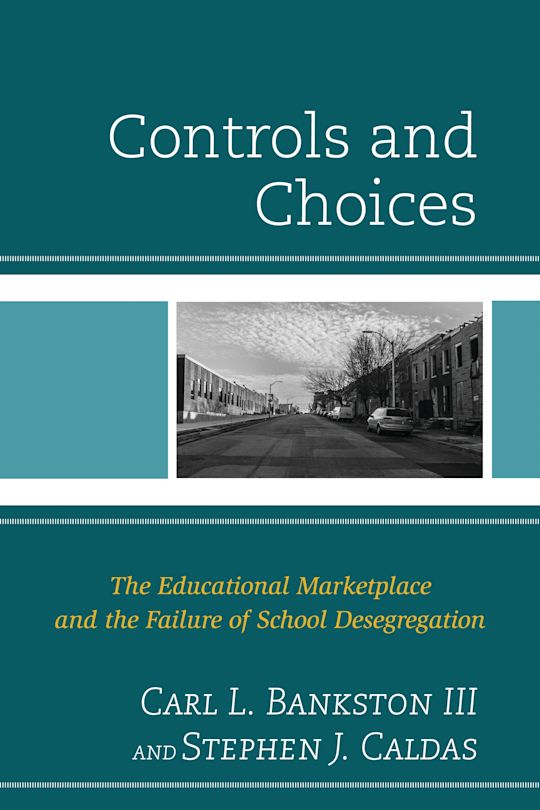- Home
- ACADEMIC
- Education
- Education - Other
- Controls and Choices
Controls and Choices
The Educational Marketplace and the Failure of School Desegregation
Controls and Choices
The Educational Marketplace and the Failure of School Desegregation
You must sign in to add this item to your wishlist. Please sign in or create an account
Description
Many activists and writers have ascribed continuing racial segregation in American schools to a failure of will. In this view, forced transfers of students and other aggressive judicially mandated policies would lead to greater equality in education if only legislators and judges had the will to continue trying to make school districts conform to plans for redesigning schools and even American society.
Controls and Choices: The Educational Marketplace and the Failure of School Desegregation provides a detailed examination of the nature of the educational marketplace, supported by historical evidence, to argue that school desegregation failed because it involved monopolistic efforts at redistributing opportunities. These efforts were fundamentally at odds with the self-interest of the families who had the greatest ability to make choices in the educational marketplace. The authors use the concept of the educational marketplace to explain how market-based attempts at school reform, notably vouchers and charter schools, have grown out of the failure of desegregation and remain hampered by lack of recognition of how the schools really function as markets. Some additional key features of this book include:
Gives a clear understanding of how schools function as marketsIllustrates the argument with histories of specific school districtsLinks the history of school desegregation to school vouchers and charter schoolsIncludes easy to read and interpret graphs and figures Includes most up-to-date school population and census information
Table of Contents
Introduction
Background: The Evolution of Educational Redistribution
Failure of Will or Self-Defeating Policy?
Summary of the Book
Chapter 1 — The Political Economy of Education and Equality of Educational Opportunity
Why Seek Equality of Opportunity in Education?
What Makes an Education Valuable?
More than Money
It’s the Clientele
Chapter Summary
Chapter 2 — Schooling as a Competitive Market
The Educational Marketplace
School Composition and Educational Environments
What Does This Mean for Equality of Opportunity?
The School Marketplace in Practice
Chapter Summary
Chapter 3— Command and Control Failures: Cases of Self-Defeating Policies
Baton Rouge, Louisiana
Chicago, Illinois
Dallas, Texas
Beaumont, Texas
Pasadena, California
New York City
Indianapolis, Indiana
Detroit, Michigan
Boston, Massachusetts
Louisville-Jefferson County
Chapter Summary
Chapter 4— Market Options and Illusions of Success
Little Rock, Arkansas
Charlotte, North Carolina
Milwaukee, Wisconsin
St. Louis, Missouri
What Happened in These Districts?
Chapter Summary
Chapter 5—The Educational Marketplace and the Rise of the School Choice Movement
Desegregation Frustration and the Rise of Charters
Minority Students and Vouchers
The Spread of School Choice Reforms
The Special Case of New Orleans
Summary of Rationale for Using Charters and Vouchers for Redistribution
The Debate over Choice
Desegregation, School Choice, and Educational Quality
Chapter Summary
Conclusion
References
Product details
| Published | 08 Jul 2015 |
|---|---|
| Format | Ebook (Epub & Mobi) |
| Edition | 1st |
| Extent | 162 |
| ISBN | 9781475814705 |
| Imprint | Rowman & Littlefield Publishers |
| Illustrations | 6 BW Illustrations |
| Publisher | Bloomsbury Publishing |
About the contributors
Reviews
-
Beginning with the premise that education is a business monopoly supplying clientele for the marketplace, equity in education falls short. Comparing the populations in low socioeconomic schools with those that are advantaged and mostly white clarifies that inequity exists. The former is of less value to consumers. Further, equity in education is not necessary to provide the skills required. It does not mirror marketplace reality. Though redistribution of diverse populations through desegregation was a noble civil rights goal, it sped up segregation. Mandated attempts achieved nothing more than an initial appearance of equity, and mandated redistribution encouraged the advantaged to relocate. Deciding where they could get the best education for their children, such as private, parochial, or magnet schools, middle- and upper-class families moved. This mobility, ‘white flight,’ demographically reestablished the gap that desegregation was intended to address. One chapter provides several in-depth examples of desegregation failures. Another chapter outlines those claiming success, such as in-school desegregation; however, even those suffered from many of the same maladies. In short, after decades of desegregation in the US, desegregation has proved to be ineffective in providing educational equity.
Summing Up: Recommended. Graduate students; faculty.Choice Reviews
-
Carl Bankston and Stephen Caldas have once again produced an iconoclastic, insightful book on the failure of school desegregation to produce the outcomes that most of us thought were possible after the Coleman Report of 1966. Their argument is that education, whether public or private, is a marketplace and the problem with mandatory reassignment school desegregation plans is that it converts the education marketplace into a monopoly. Those with the means to do so opt out of this monopoly and those who do not have the means stay and the outcome has been a decline in integration rather than an increase. My own research shows the same thing.
Christine Rossell, professor emerita of political science, Boston University
-
This book breaks new ground in the Sociology of Education. Bankston and Caldas deftly describe how market forces play a powerful role in shaping the education of our youth.
John C. Kilburn Jr., associate dean of research, Texas A&M International University
-
If you want to know anything about school desegregation, its successes but mostly failures, then you MUST read this book. In a short 162 pages, it is positively encyclopedic in its coverage of this important issue. This book is not limited to an empirical examination of the phenomenon. It also delves into the philosophical and ethical aspects of school desegregation. It is a scholarly book, but accessible to anyone interested in the subject, and that should include just about everyone.
Walter E. Block



































